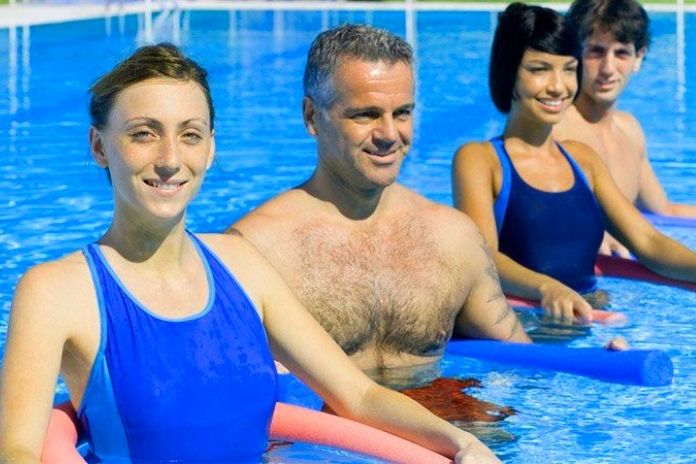We can scratch each other’s backs at the edge of the pool – or turn the outdoor pool into an open-air gym! While doing water workouts Sweat flows – but the fun never comes from swimming.
As soon as the thermometer cracks the 20-degree mark, we flock to local Oceania.
Finally, chlorine water evaporates on hot concrete slabs in the nose again. Screaming, bustling, splashing, and the snort of the almost empty sunscreen bottle in your ear.
With shriveled fingers, there are delicious fries with mayo and hopefully plenty of sun on your pre-tanned skin.
But the outdoor pool has a lot more to offer than just lying around comfortably with terry towels. It’s also the perfect playground to get fit!
A day at the pool burns just as many calories as a hard day at the gym.
The colder the water, the higher the fat-burning rate. And the more we move, the higher the fun factor. In addition, the stress on the joints is around 90 percent less in the water than on land because H2O is about 1,000 times denser than air.
So you can hardly get in shape more gently.
Aqua Cycling
At first glance, it probably sounds like a sport for seniors. Still, cycling in the water is enjoying growing popularity among young people because aqua cycling can burn up to 800 kcal per hour.
On top of that, it’s a good workout against cellulite since the movement in the water massages the skin and muscles like lymphatic drainage and helps to remove the sludge that has accumulated.
This shapes the bottom and legs and tightens the muscles throughout the body.
Diving
The large muscle groups in the buttocks and legs burn a lot of energy when climbing stairs. Dare to level up with every jump; work your way up from one to five.
The ten-meter tower is more of a borderline experience: Even lifeguards don’t have to jump higher than the threesome during the test.
It doesn’t matter where your limit lies: Enjoy the adrenaline rush! Your body is under tension while jumping, and the temperature difference in the water causes your metabolism to run at full speed, burning additional calories.
Swimming
Clear the path! We float in the water – and that saves energy. But its high density also ensures that the resistance is enormous. Swimming uses the upper and lower body equally; the cardiovascular system is stressed but not overloaded.
Of course, swimming is a lot of fun if you master the technique correctly. But even breast-swimming “seahorses” burn around 530 kcal per hour, crawling “sharks” come up to 900 kcal.
Water Polo
In water polo, the players of two teams try to throw the ball into the opposing goal through skillful passes and free swimming.
You don’t have to join a club and train seriously to play water polo. It’s enough if you grab your best buddies and you try to take the ball from each other in the water.
Because splashing around in the water is an effective full-body workout that strengthens the entire musculature, especially in the arms, back, and stomach.
The deeper you stand in the water, the greater the training effect. The cardiovascular system also benefits from playing ball games in the water.
Slides
You loved slides as a kid, but since you’ve left adolescence, do you feel too grown-up to slide? Put your inhibitions aside. Sliding is fun!
Challenge each other: Who slides faster? Who dares to slide headfirst? (Safety first – but annoying lifeguards is part of it, isn’t it?)
The side effect: Climbing the stairs also burns a few calories. Climbing stairs for 15 minutes, for example, requires a total of 70 kcal – and ten minutes of sliding with body tension adds another 50 kcal.
Float Fit
With the so-called Float fit, you perform various exercises on an air-filled mat on the water. The mix of intensive intervals and yoga and relaxation exercises ensures variety in this effective all-around program.
The motto here is: find balance and push through. If you fall into the water from time to time, that’s perfectly fine and provides an extra portion of fun.
Because while balancing on the board, you playfully improve your sense of balance, your posture, mobility, and endurance. Your deep muscles are also activated.
The courses are primarily short and crisp – they usually last just 30 minutes.
Also Read: Metabolic Types: The Best Workout For Your Physique

